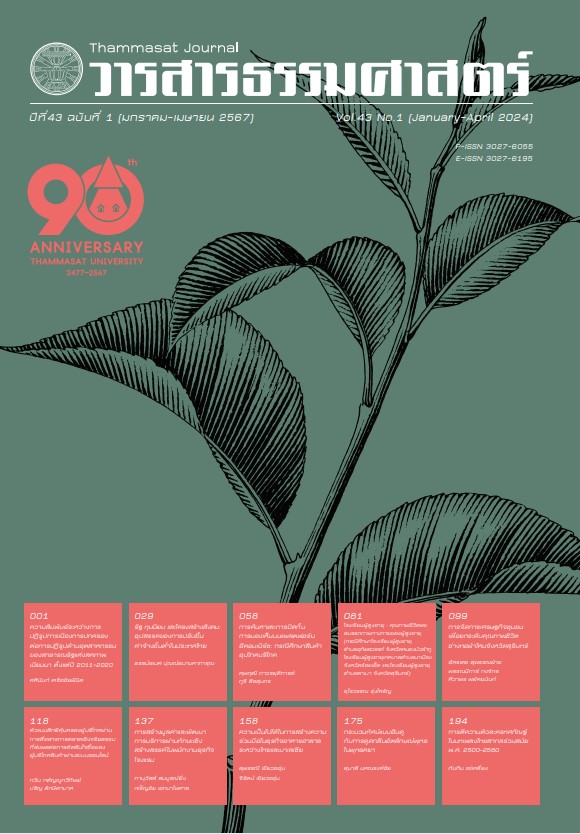A Model of Consumer Rights Protection via Ethics Marketing Communication Affecting Purchasing Decision of Online Consumers
Main Article Content
Abstract
The research aimed at studying a model of consumer rights protection via ethics marketing communication affecting the purchasing decision of online consumers. It used a survey research approach with Structural Equation Modeling. (SEM). Questionnaires were constructed as the research tool for collecting data from 884 online consumers. The research findings indicated that the developed model of consumer rights protection via ethics marketing communication channels affecting the purchasing decision of online consumers had validity and predictive ability at a good level with acceptability at 84.7%. At a statistical significance level of 0.05, the researchers found that the right to be safe, the right to receive information, the right to be free to buy, the right to be fair in contracting and the right to be compensated for damages had a causal relationship with ethics marketing communication. Furthermore, the right to be safe, the right to receive information, the right to be free to buy, the right to be fair in contracting, the right to be compensated for damages, and ethics marketing communication had a causal relationship with affecting the purchasing decision of online consumers.
Article Details
References
กรมการปกครอง. (2563). รายงานสถิติิจำนวนประชากรและบ้าน. https://stat.bora.dopa.go.th/stat/statnew/statTDD/views/showProvinceData.php
จุฑารัตน์ เกียรติรัศมี. (2558). ปัจจัยที่มีผลต่อการซื้อสินค้าผ่านทางแอปพลิเคชันออนไลน์ของผู้บริโภคในเขตกรุงเทพมหานครและปริิมณฑล. [การศึกษาค้นคว้าอิสระปริญญาบริหารธุรกิจมหาบัณฑิต]. มหาวิทยาลัยธรรมศาสตร์.
ณรงค์ โพธิ์พฤกษานันท์. (2551). ระเบียบวิธีวิจัย. กรุงเทพฯ: เอ็กซเปอร์เน็ท, 52-60.
นงลักษณ์ วิรัชชัย. (2555). ความสัมพันธ์์โครงสร้างเชิงเส้น (LISREL): สถิติวิเคราะห์์สำหรับการวิจัยทางสังคมศาสตร์์และพฤติกรรมศาสตร์. กรุงเทพฯ: สำนักพิมพ์์แห่งจุฬาลงกรณ์มหาวิทยาลัย.
ปริญ ลักษิตามาศ. (2558). จิตวิทยาและพฤติิกรรมผู้บริโภค. กรุงเทพฯ: โรงพิมพ์์มหาวิทยาลัยธรรมศาสตร์์.
ปุลณัช เดชมานนท์์. (2556). การตัดสินใจซื้อสินค้าผ่านสื่อเครือข่ายสังคมออนไลน์ในช่วงเวลาจำกัด. [การศึกษาค้นคว้าอิสระปริญญาบริหารธุรกิจมหาบัณฑิต]. มหาวิทยาลัยเทคโนโลยีราชมงคลธัญบุรี.
สำนักงานคณะกรรมการคุ้มครองผู้บริโภค. (2558). ข้อแนะนำสำหรับผู้บริโภค. https://www.ocpb.go.th/news_view.php?nid=36
สำนักงานปลัดกรุงเทพมหานคร. (2559). ข้อมูลการแบ่งพื้นที่่ กรุงเทพ. กรุงเทพฯ: สำนักงานปลัดกรุงเทพมหานคร, กองควบคุมและจัดการคุณภาพ.
สำนักบริหารเทคโนโลยีสารสนเทศจุฬาลงกรณ์มหาวิทยาลัย. (2560). เปรียบเทียบ พ.ร.บ.คอมฯ พ.ศ. 2550 และ พ.ร.บ.คอมฯ พ.ศ. 2550 ซึ่งแก้ไขเพิ่มเติมโดย พ.ร.บ.คอมฯ พ.ศ. 2560. https://shorturl.asia/4lvou
สุุชาติ ประสิทธิ์ รัฐสินธุ์ . (2551). เทคนิคการวิเคราะห์ตัวแปรหลายตัวสำหรับการวิจัยทางสังคมศาสตร์์และพฤติิกรรมศาสตร์์ (คู่มือนักวิิจัยและนักศึกษาระดับปริญญาโท และปริญญาเอก) : หลักการวิธีการ และการประยุกต์ (พิมพ์ครั้งที่ 6). กรุุงเทพฯ: สามลดา.
สุวิมล ติรกานันท์. (2550). ระเบียบวิธีวิจัยทางสังคมศาสตร์: แนวทางปฏิบััติ. กรุงเทพฯ: โรงพิมพ์์จุฬาลงกรณ์มหาวิทยาลััย, 44-46.
Arbuckle, J. J. (1995). AMOS user, s guide. Chicago: Small Waters Corporation.
Blythe, J. (2008). Consumer behavior. London: Thomson Learning.
Bollen, K. A. (1989). Structure equations with latent variables. New York: John Wiley & Sons, 257-258.
Brown, M. W., & Cudeek, R. (1993). Alliterative ways of assessing model fit, in testing structural equation model. New Jersey: Sage Publication, 270.
Chawla, N., & Kumar, B. (2021). E-commerce and consumer protection in India: The emerging trend. Journal of Business Ethics, 180, 581-604.
Cochran, W. G. (1977). Sampling Techniques. (3rd ed.). New York: John Wiley & Sons, 203.
Coothoopermal, S., & Chittoo, H. (2017). The impact of consumer decision-making styles on consumer confusion in Mauritius: An empirical analysis. International Journal of Consumer Studies, 41(3), 312-313.
Cronbach, L. J. (2003). Essential of psychology testing. New York: Hanper Collishes. East, R., Wright, M., & Vanhuele, M. (2008). Consumer behavior: Applications in marketing. London: Sage.
Hair, J. F., Black, W.C., Babin, B.J., & Anderson, R.E. (2014). Multivariate data analysis. (7th ed.). Essex: Pearson Education Ltd.
Hawkins, D. I., & Mothersbaugh, D. L. (2010). Consumer behavior: Building marketing strategy (11th ed.). New York: McGraw-Hill Irwin.
Hoogland, J. J., & Boomsma, A. (1998). Robustness studies in covariance structure modeling: An overview and a meta-analysis. Sociological Methods & Research, 26(3), 329-367.
Hu, L., & Bentler, P. M. (1999). Cutoff criteria for fit indexes in covariance structure analysis: Conventional criteria versus new alternatives. Structural Equation Modeling, 6(1), 1-55.
Joreskog, K. G., & Sorbom, D. (1993). Lisrel 8: Structural equation modeling with the simplis command language. Chicago: Software International, 26.
Kardes, F. R., Cronley, M. L., & Cline, T. W. (2011). Consumer behavior. South-Western, Cengage Learning.
Kline, P. (1994). An easy guide to factor analysis. London & NY: Routledge, 28-41.
Kotler, P. (2003). Marketing management (11th ed.). NJ: Upper Saddle River, Prentice-Hall.
O’Neil, J., & Eisenmann, M. (2017). An examination of how source classification impacts credibility and consumer behavior, Pubilc Relations Review, 43(2), 278-292.
Saris, W. E., & Strenkhorst, L. H. (1984). Causal modeling non experimental research: An introduction to the lisrel approach. Dissertation Abstract International, 47(7), 2261-A.
Shang, Shari S. C., Wu, Ya-Ling., & Sie, Yi-Jhen. (2017). Generating consumer resonance for purchase intention on social network sites. Computers in Human Behavior, 69(4), 18-28.
Shepherd, H. L., Barratt, A., Jones, A., Bateson, D., Carey, K., Trevena, L. J., McGeechan, K., Del Mar, C. B., Butow, P. N., Epstein, R. M., Entwistle, V., & Weisberg, E. (2016).
Can consumers learn to ask three questions to improve shared decision making? A feasibility study of the ASK (AskShareknow) patient-clinician communication model intervention in a primary health-care setting. Health Expectations, 19(5), 1160-1169.
SM Magazine. (2020). Instagram, the online business platform for millennials. SM Magazine, 19(213), 74-75
Taro, Y. (1973). Statistic: An Introductory Analysis. New York: Harper & Row Wang, Y. (2020). Research on the effect of 4C+2S to customer perceived value in scene marketing of clothing industry in China. Open Journal of Business and Management, 8(2), 628-638.
Xie, G. X., Madrigal, R., & Boush, D. (2015). Disentangling the effects of perceived deception and anticipated harm on consumer responses to deceptive advertising. Journal of Business Ethics, 129(2), 281-293.

